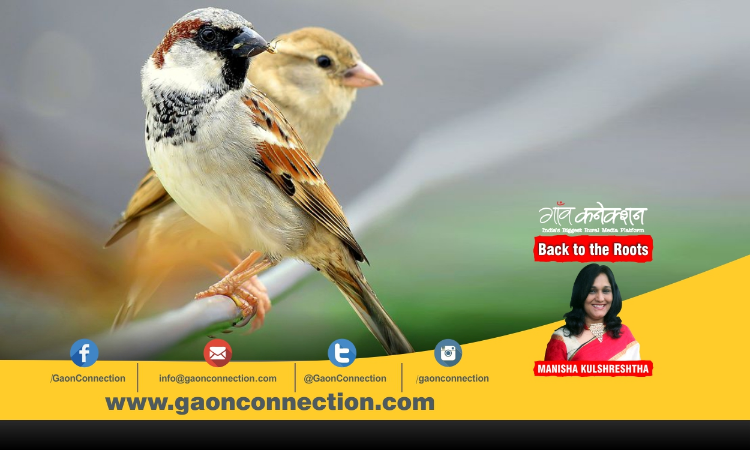Sparrow In My Childhood Memories
Manisha Kulshreshtha remembers her childhood when the sparrow was a part of our lives and wishes that we would all do something to bring it back, along with the simpler times that were.
 Manisha Kulshreshtha 7 Oct 2018 6:35 AM GMT
Manisha Kulshreshtha 7 Oct 2018 6:35 AM GMT

Do you remember the time your dadi, nani or amma, would be making rotis. And just to distract you when you tried to get their attention, they would give you a little bird fashioned out of dough? Twigs would make its feet. Black pepper-corns its eyes. I would even put my dough bird in the fire to cook. My brother loved soaking this bird in desi ghee and eat it one big bite! Oh to be a child again!
We would call the goraiyya (common sparrow) just chidiya. Yes, I know that chidiya is just another word for bird, not goraiyya, but that is how it was. We had a story – Ek thi chidiya, ek tha chirauta (The Story of a Girl Bird and a Boy Bird). The girl bird would get the dal; the boy bird would get the rice. These birds were our hero and heroine in our story, because they were such a common part of our existence. We would see them everywhere – enjoying a mud bath in the courtyard; quenching their thirst from the big pot of water; and some bold ones also had the temerity to steal some flour even as my mother would be kneading the dough. They would pick up straggly pieces of hay and dried grass and try to make their homes in any hole-in-the-wall, ventilator or just any space in the house they liked. Living up to its English name – House Sparrow!
Don't you miss them? Have you noticed how they are no longer comfortable around humans? They have stopped making their nests in our homes. Where have they gone? Has the noise of our traffic driven them away? Do the waves of the mobile phone signals bother them? Or have they disappeared because we have stopped putting out food and water for them as we live our cloistered lives in flats? We have become quite selfish. Now if you are lucky, you might find a sparrow in some open-empty building, hiding in bougainvillea bushes or maybe in the open fields. No longer near our homes.
Also read: From darkness to light: Discard superstitions and outdated traditions
But she remembers you – sadly trying to find those children who played the game 'chidiya ud' (flyaway birdie); who spilled more of the roasted chana than they ate. Those housewives who thought seeing birds playing in the dust was an auspicious welcome to the rains. They would deliberately spill rice in the courtyard for them. Now those children are busy with video games and mobiles and those housewives are tied to the television. The sparrow has been abandoned.
Our houses may have become bigger but our hearts have shrunk. There is money aplenty, but the feeling of caring for smaller creatures has disappeared. The number of house sparrows left in the world is only about 20 percent of what is used to be. Possibly because of our modern lifestyle. We get flour in bags, there is no grain spilled outside the store-room for the sparrows to pick on. Water is no longer kept in pots, it is in cold bottles in the fridge. There is no hole-in-the-wall for the sparrow to nest in.
The sparrow would also make her nest in small trees and bushes. Even those are being destroyed by us. We are destroying the old trees and not planting any new ones. Kaner, babul, lemon, guava, pomegranate trees are the sparrow's favourite places to nest. But we don't have any space for these beautiful trees anymore. We need the space to make more rooms. We don't have the time to spare for the sparrow. The sparrow would have survived on the seeds of grass also had we left some gardens greens. Everything is being concretised, who wants to put in the effort of maintaining a garden. Even the mobile towers that have sprouted in our cities and villages are deadly for sparrows. The electromagnetic waves emitted by these affect the fertility of the birds. Sparrows fed on bajra, grain, rice and worms. But our modern lifestyles have snatched away the sparrow's natural sources of food.
Also read: Learn the art of saving water from those who live without it – the people of the desert
But, if we make even small changes we can bring back the sparrow. If she decides to make her nest in our homes, let us welcome her and not destroy the nest. Make it a habit to leave some grain and water for them on our window sills and in our courtyards. Who knows how many sparrows die every summer because of thirst. We can also make nests for them in little pots and hang them. And protect her eggs from predators like cats or bigger birds.
So if you want that sparrow who was a part of your childhood back, then just give it love, water, grain and a place to live. She will return, to take us back to our childhoods.
(About the Writer: Manisha Kulshreshtha is a popular Hindi writer born and educated in Rajasthan. Her upbringing as an army child made her footloose and her travels enriched her soul. Honoured with several awards and fellowships, Manisha published seven collections of stories and four novels. Manisha is a Senior Fellow with the Cultural Department and is working on a travelogue -- Meghdoot Ki Rah Par. Her works have been translated into Russian, Dutch and English. Her work has afforded her the opportunity to travel around the world.)
More Stories




